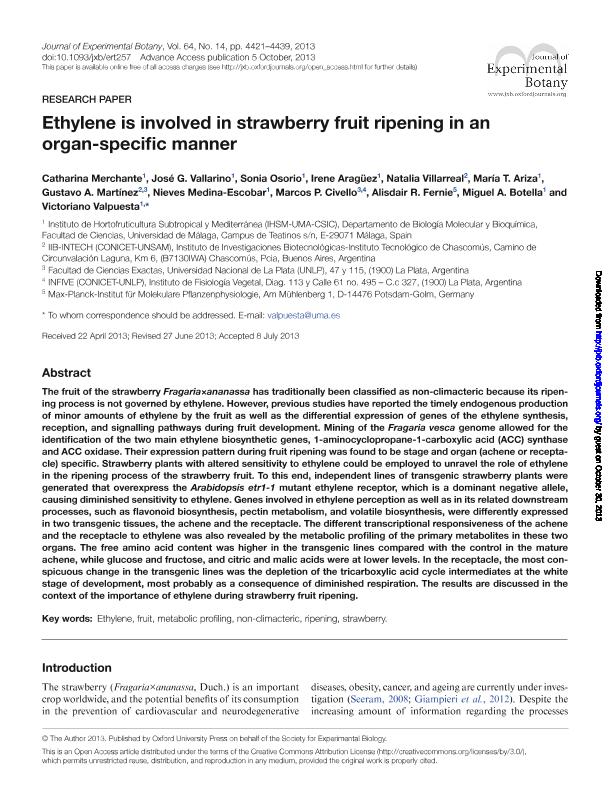Artículo
Ethylene is involved in strawberry fruit ripening in an organ-specific manner
Merchante, Catharina; Vallarino, Jose G.; Osorio, Sonia; Aragüez, Irene; Villarreal, Natalia Marina ; Ariza, Maria T.; Martinez, Gustavo Adolfo
; Ariza, Maria T.; Martinez, Gustavo Adolfo ; Medina Escobar, Nieves; Civello, Pedro Marcos
; Medina Escobar, Nieves; Civello, Pedro Marcos ; Fernie, Alisdair R.; Botella, Miguel A.; Valpuesta, Victoriano
; Fernie, Alisdair R.; Botella, Miguel A.; Valpuesta, Victoriano
 ; Ariza, Maria T.; Martinez, Gustavo Adolfo
; Ariza, Maria T.; Martinez, Gustavo Adolfo ; Medina Escobar, Nieves; Civello, Pedro Marcos
; Medina Escobar, Nieves; Civello, Pedro Marcos ; Fernie, Alisdair R.; Botella, Miguel A.; Valpuesta, Victoriano
; Fernie, Alisdair R.; Botella, Miguel A.; Valpuesta, Victoriano
Fecha de publicación:
05/10/2013
Editorial:
Oxford University Press
Revista:
Journal of Experimental Botany
ISSN:
0022-0957
Idioma:
Inglés
Tipo de recurso:
Artículo publicado
Resumen
The fruit of the strawberry Fragaria×ananassa has traditionally been classified as non-climacteric because its ripening process is not governed by ethylene. However, previous studies have reported the timely endogenous production of minor amounts of ethylene by the fruit as well as the differential expression of genes of the ethylene synthesis, reception, and signalling pathways during fruit development. Mining of the Fragaria vesca genome allowed for the identification of the two main ethylene biosynthetic genes, 1-aminocyclopropane-1-carboxylic acid (ACC) synthase and ACC oxidase. Their expression pattern during fruit ripening was found to be stage and organ (achene or receptacle) specific. Strawberry plants with altered sensitivity to ethylene could be employed to unravel the role of ethylene in the ripening process of the strawberry fruit. To this end, independent lines of transgenic strawberry plants were generated that overexpress the Arabidopsis etr1-1 mutant ethylene receptor, which is a dominant negative allele, causing diminished sensitivity to ethylene. Genes involved in ethylene perception as well as in its related downstream processes, such as flavonoid biosynthesis, pectin metabolism, and volatile biosynthesis, were differently expressed in two transgenic tissues, the achene and the receptacle. The different transcriptional responsiveness of the achene and the receptacle to ethylene was also revealed by the metabolic profiling of the primary metabolites in these two organs. The free amino acid content was higher in the transgenic lines compared with the control in the mature achene, while glucose and fructose, and citric and malic acids were at lower levels. In the receptacle, the most conspicuous change in the transgenic lines was the depletion of the tricarboxylic acid cycle intermediates at the white stage of development, most probably as a consequence of diminished respiration. The results are discussed in the context of the importance of ethylene during strawberry fruit ripening.
Palabras clave:
Ethylene
,
Fruit
,
Metabolic Profiling
,
Non-Climacteric
,
Ripening
,
Strawberry
Archivos asociados
Licencia
Identificadores
Colecciones
Articulos(CCT - LA PLATA)
Articulos de CTRO.CIENTIFICO TECNOL.CONICET - LA PLATA
Articulos de CTRO.CIENTIFICO TECNOL.CONICET - LA PLATA
Articulos(IIB-INTECH)
Articulos de INST.DE INVEST.BIOTECNOLOGICAS - INSTITUTO TECNOLOGICO CHASCOMUS
Articulos de INST.DE INVEST.BIOTECNOLOGICAS - INSTITUTO TECNOLOGICO CHASCOMUS
Citación
Merchante, Catharina; Vallarino, Jose G.; Osorio, Sonia; Aragüez, Irene; Villarreal, Natalia Marina; et al.; Ethylene is involved in strawberry fruit ripening in an organ-specific manner; Oxford University Press; Journal of Experimental Botany; 64; 14; 5-10-2013; 4421-4439
Compartir
Altmétricas



